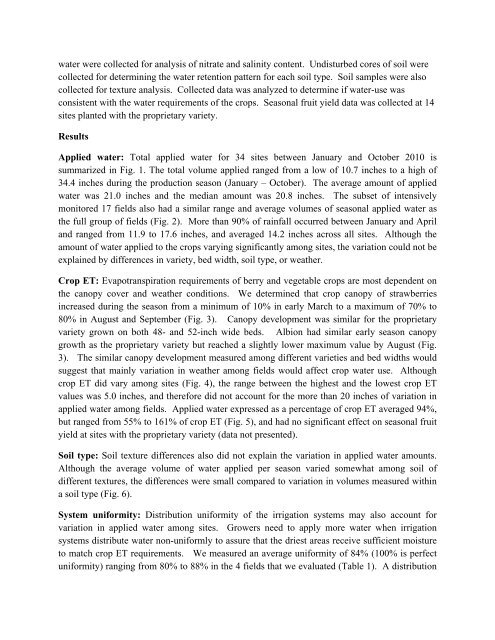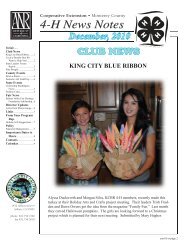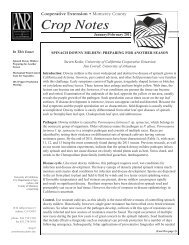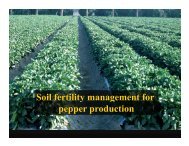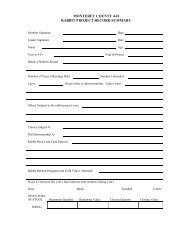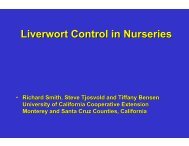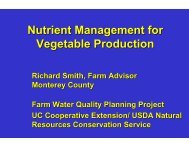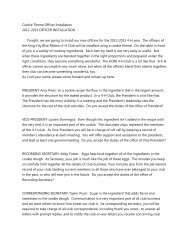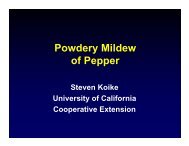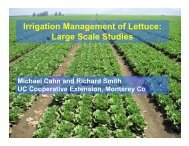Strawberry water use on the Central Coast Michael Cahn, Barry ...
Strawberry water use on the Central Coast Michael Cahn, Barry ...
Strawberry water use on the Central Coast Michael Cahn, Barry ...
Create successful ePaper yourself
Turn your PDF publications into a flip-book with our unique Google optimized e-Paper software.
<str<strong>on</strong>g>water</str<strong>on</strong>g> were collected for analysis of nitrate and salinity c<strong>on</strong>tent. Undisturbed cores of soil were<br />
collected for determining <strong>the</strong> <str<strong>on</strong>g>water</str<strong>on</strong>g> retenti<strong>on</strong> pattern for each soil type. Soil samples were also<br />
collected for texture analysis. Collected data was analyzed to determine if <str<strong>on</strong>g>water</str<strong>on</strong>g>-<str<strong>on</strong>g>use</str<strong>on</strong>g> was<br />
c<strong>on</strong>sistent with <strong>the</strong> <str<strong>on</strong>g>water</str<strong>on</strong>g> requirements of <strong>the</strong> crops. Seas<strong>on</strong>al fruit yield data was collected at 14<br />
sites planted with <strong>the</strong> proprietary variety.<br />
Results<br />
Applied <str<strong>on</strong>g>water</str<strong>on</strong>g>: Total applied <str<strong>on</strong>g>water</str<strong>on</strong>g> for 34 sites between January and October 2010 is<br />
summarized in Fig. 1. The total volume applied ranged from a low of 10.7 inches to a high of<br />
34.4 inches during <strong>the</strong> producti<strong>on</strong> seas<strong>on</strong> (January – October). The average amount of applied<br />
<str<strong>on</strong>g>water</str<strong>on</strong>g> was 21.0 inches and <strong>the</strong> median amount was 20.8 inches. The subset of intensively<br />
m<strong>on</strong>itored 17 fields also had a similar range and average volumes of seas<strong>on</strong>al applied <str<strong>on</strong>g>water</str<strong>on</strong>g> as<br />
<strong>the</strong> full group of fields (Fig. 2). More than 90% of rainfall occurred between January and April<br />
and ranged from 11.9 to 17.6 inches, and averaged 14.2 inches across all sites. Although <strong>the</strong><br />
amount of <str<strong>on</strong>g>water</str<strong>on</strong>g> applied to <strong>the</strong> crops varying significantly am<strong>on</strong>g sites, <strong>the</strong> variati<strong>on</strong> could not be<br />
explained by differences in variety, bed width, soil type, or wea<strong>the</strong>r.<br />
Crop ET: Evapotranspirati<strong>on</strong> requirements of berry and vegetable crops are most dependent <strong>on</strong><br />
<strong>the</strong> canopy cover and wea<strong>the</strong>r c<strong>on</strong>diti<strong>on</strong>s. We determined that crop canopy of strawberries<br />
increased during <strong>the</strong> seas<strong>on</strong> from a minimum of 10% in early March to a maximum of 70% to<br />
80% in August and September (Fig. 3). Canopy development was similar for <strong>the</strong> proprietary<br />
variety grown <strong>on</strong> both 48- and 52-inch wide beds. Albi<strong>on</strong> had similar early seas<strong>on</strong> canopy<br />
growth as <strong>the</strong> proprietary variety but reached a slightly lower maximum value by August (Fig.<br />
3). The similar canopy development measured am<strong>on</strong>g different varieties and bed widths would<br />
suggest that mainly variati<strong>on</strong> in wea<strong>the</strong>r am<strong>on</strong>g fields would affect crop <str<strong>on</strong>g>water</str<strong>on</strong>g> <str<strong>on</strong>g>use</str<strong>on</strong>g>. Although<br />
crop ET did vary am<strong>on</strong>g sites (Fig. 4), <strong>the</strong> range between <strong>the</strong> highest and <strong>the</strong> lowest crop ET<br />
values was 5.0 inches, and <strong>the</strong>refore did not account for <strong>the</strong> more than 20 inches of variati<strong>on</strong> in<br />
applied <str<strong>on</strong>g>water</str<strong>on</strong>g> am<strong>on</strong>g fields. Applied <str<strong>on</strong>g>water</str<strong>on</strong>g> expressed as a percentage of crop ET averaged 94%,<br />
but ranged from 55% to 161% of crop ET (Fig. 5), and had no significant effect <strong>on</strong> seas<strong>on</strong>al fruit<br />
yield at sites with <strong>the</strong> proprietary variety (data not presented).<br />
Soil type: Soil texture differences also did not explain <strong>the</strong> variati<strong>on</strong> in applied <str<strong>on</strong>g>water</str<strong>on</strong>g> amounts.<br />
Although <strong>the</strong> average volume of <str<strong>on</strong>g>water</str<strong>on</strong>g> applied per seas<strong>on</strong> varied somewhat am<strong>on</strong>g soil of<br />
different textures, <strong>the</strong> differences were small compared to variati<strong>on</strong> in volumes measured within<br />
a soil type (Fig. 6).<br />
System uniformity: Distributi<strong>on</strong> uniformity of <strong>the</strong> irrigati<strong>on</strong> systems may also account for<br />
variati<strong>on</strong> in applied <str<strong>on</strong>g>water</str<strong>on</strong>g> am<strong>on</strong>g sites. Growers need to apply more <str<strong>on</strong>g>water</str<strong>on</strong>g> when irrigati<strong>on</strong><br />
systems distribute <str<strong>on</strong>g>water</str<strong>on</strong>g> n<strong>on</strong>-uniformly to assure that <strong>the</strong> driest areas receive sufficient moisture<br />
to match crop ET requirements. We measured an average uniformity of 84% (100% is perfect<br />
uniformity) ranging from 80% to 88% in <strong>the</strong> 4 fields that we evaluated (Table 1). A distributi<strong>on</strong>


